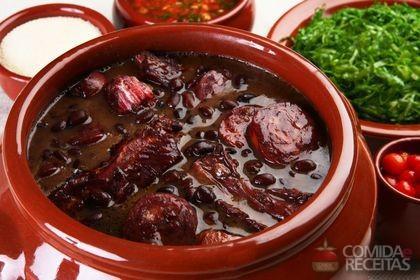BRAZILIAN DISHES THAT HAVE MARKED MY TRAJECTORY



Food is one of few concepts that transcends borders and applies to humanity, almost universally. My unique involvement with food can certainly be considered holistic, given my immigration from São Paulo, Brazil to Boca Raton, FL at the age of 6. The intermingling of many food items was certainly common in my upbringing, but in this blog I will concentrate on some of the fundamental Brazilian dishes that still form part of my life today: feijoada (sort of like a bean stew-like dish), pão de queijo (cheese bread) and pudim de leite (similar to flan). These three Brazilian dishes have carried their weight in not just sustaining me, but bringing me genuine connection to my origins and my overall identity as a Brazilian immigrant. These food items have been integral in shaping Brazil as a country of rich, delicious food that is especially intermingled with its culture and history. Feijoada dates back to slavery in Brazil, when slaves would use the undesired parts of meat to make this highly nutritious bean-like stew. Pão de queijo’s origin is still uncertain, but it has paved its way to being an appetizer-like dish in almost every Brazilian community across the world. Lastly, pudim de leite conjoins Portugal and Brazil in a special manner, as this tasty dessert which was once a secret recipe has connected the former colony with its colonizer in an interesting way. Images of these dishes can be found above, respectively.
These food items represent a whole lot for me, and as foreshadowed earlier, they have helped me carve out my sense of self early on and have made their way in becoming a part of my everyday meals. Of course, the question that begs is: Why? This is quite a complex question to answer because the reasonings that these foods were presented to me vary and as I think back, it was before my intellect was sharp enough to inquire what the relevance of these foods are. As I have matured and have decided to dig deeper into my cultural background as it pertains to food, I have discovered the prominence of these dishes in my south Floridian environment. While of course these foods are Brazilian by birth, they have made their way across borders and have become ever so common here in the States, where Brazilian communities have arisen. In particular, Saturday’s are “feijoada” days in many Brazilian restaurants here in south Florida. Ever since my childhood, I’d frequently have this dish on a Saturday, but never caught on to the pattern until recently. Furthermore, Brazilians have a tendency to have a small “meal” between lunch and dinner, called café da tarde, which is sort of like a mid-afternoon coffee break. These “meals” often combine coffee with bread–almost always, during my upbringing, pão de queijo was present, and my eyes would sparkle in joy as I heard the oven *ding*, and I quickly raced to the kitchen to fearlessly devour them one-by-one, time after time again. For every savory dish, comes an even better sweet dish, so the Brazilian say. A complete meal was something that was constantly emphasized as I grew up; thus, I would look forward to eating pudim de leite after (almost) every meal (regardless if lunch or dinner), no matter the occasion. This dish represented a sense of completion for me, as it usually came last, and I was always the most excited to consume it. Pudim validated my Brazilian roots because it allowed me to “show off” my Brazilian roots by having friends join me in family events, special occasions or during a weekend trip to the Brazilian buffet 5 minutes from my house. Not one non-Brazilian friend of mine disliked the dessert, and it allowed me to share a part of my culture with important people in my life, as it slowly became commonplace across south Florida, and even my classmates knew exactly what it was and how delicious it was. The combination of these three dishes represent my strong foundation in my Brazilian roots, and my ability to translate elements of my culture in such easy, simple ways. They are the reason for my confidence and my reverence for my culture and the place of my birth. As briefly mentioned earlier, these dishes in of themselves have also taught me historical lessons about their creation. Feijoada is noteworthy for its connection to slavery and the abolishment of slavery, and ultimately, the survival of former slaves. The fact this dish has become so incredibly prominent across Brazil leads me to embrace it as part of my own diet even more because of how en sync it makes me feel with my Brazil, regardless of the distance that separates me from my home country. These are a couple of the dishes that will forever be a part of my life, and I will continue to introduce people to them–of course, for their tastiness, but more importantly, because of the door it can open in letting people understand another layer of my multi-faceted identity.
The food scene in metro Atlanta intrigues me, too, because like south Florida, it is quite all encompassing and intertwined with history, immigration and culture. Particularly, I would like to hone in on Marietta as being a robust Brazilian hub that parallels my neighborhood in south Florida, given how many Brazilian restaurants and bakeries are around. This semester, I had the pleasure of attending a Brazilian restaurant with my Portuguese class, and believe it or not, we ate feijoada on a Saturday! Immediately, I felt a revitalized sense of connection with my culture that often starts to fade in bits and pieces, while I am at school. Conversing in my native language and absorbing the environment of the restaurant, I felt at home and at peace. The scents resonated with me because images of my mother and my grandmother cooking Brazilian food suddenly filled my mind, and I couldn’t help but feel joyous and thankful for who I was. Moreover, the Atlanta food scene has taught me just how powerful food is in building community and bringing the sense of home to a possibly very foreign place for individuals. In my opinion, Buford Highway serves as a perfect example of how these communities culminate together and form connection. In a place where people are from every which corner of the world, Atlanta allows people to seek a piece of familiarity in terms of food. Whether it be Ethiopian, Korean, Brazilian or fusion-like combinations, Atlanta has exposed me to cultures I have never even previously heard of, all through the medium of food. To close out, I focus on one experience I had with exploring the food scene in Atlanta: I went to get pho with a friend of mine early during my first-year at Emory on Buford Highway, and one of the managers came over to my table and whispered to us that “college students are lucky to be able to taste some of the world’s best food right at their fingertips.” Right after this comment, I took a hearty spoonful of my pho, and I silently agreed because he was absolutely correct–that pho was fantastic, and it was the first time, I’ve ever had pho. Thus, during that moment, I made a vow to continue exploring and making the most of the foodie hub we are fortunate to have in Atlanta.
PS: Click here for a pão de queijo recipe. It’s fantastic, and you will not regret making it.

A very good essay on the food that defines and excites you. I really enjoy the bit about food and its effect on personal identity. I would encourage you to expand on this part, and discuss perhaps about how these dishes have helped you over the years, in relation to your identity and self-regard, etc.